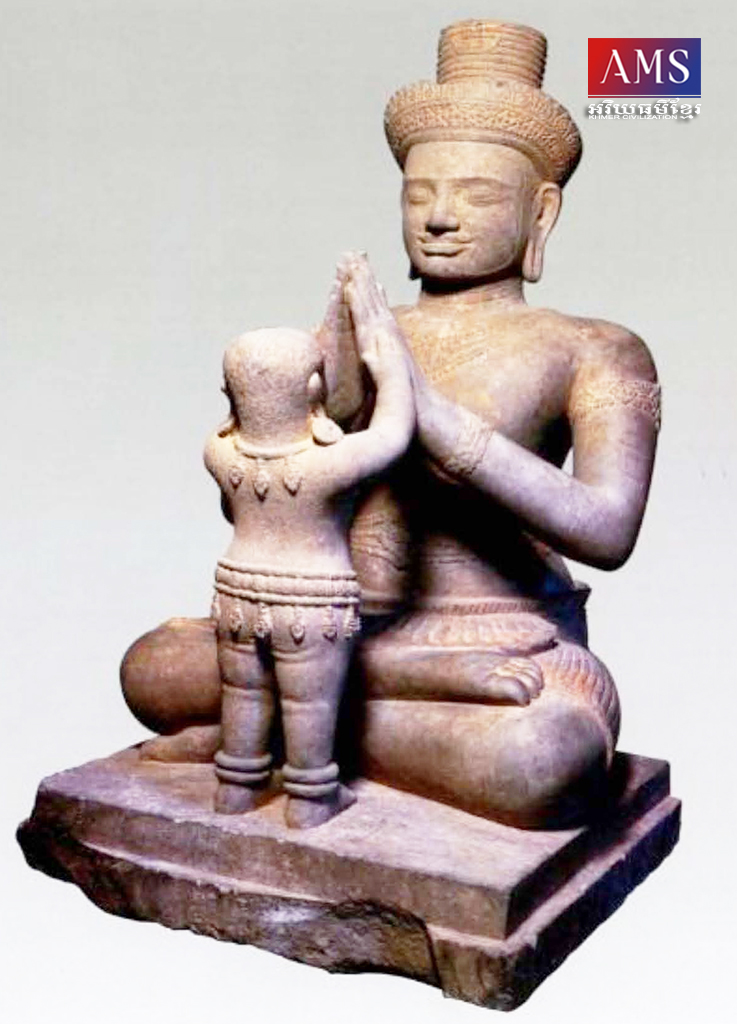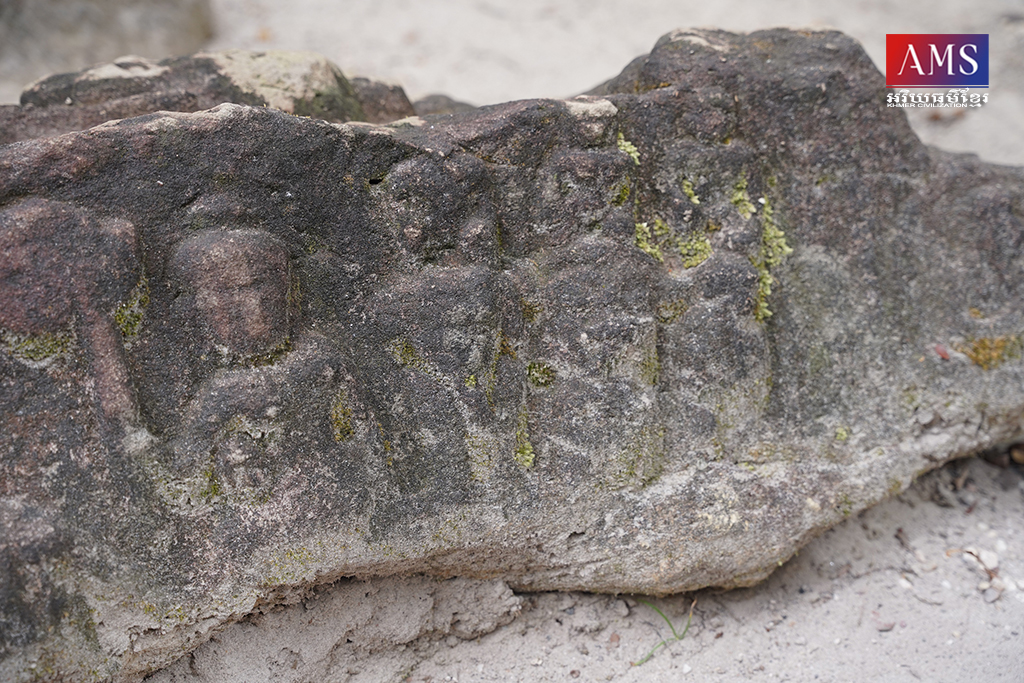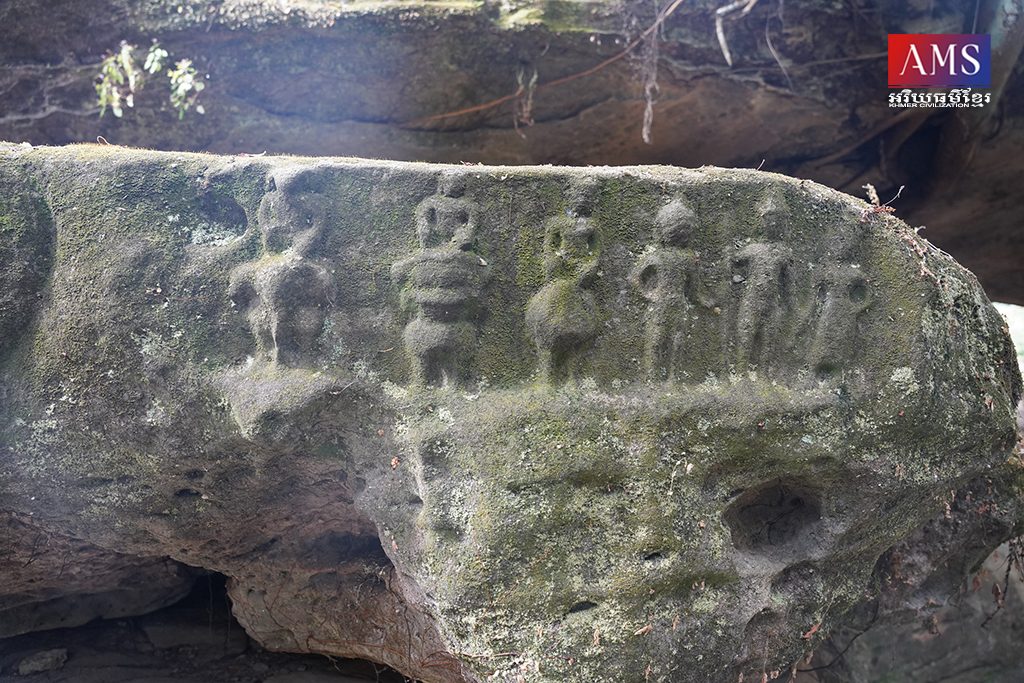សោមស្កន្ទ គឺជាទម្រង់ជាក់លាក់មួយដែលតំណាងឱ្យព្រះសិវៈ ហើយអ្នកតែងគោរពបូជាទ្រង់ គឺព្រះនាងឧមា និងព្រះស្កន្ទកាលពីក្មេង។ ការពិពណ៌នាអំពីក្រុមគ្រួសារព្រះសិវៈ គឺមានដើមកំណើតនៅឥណ្ឌាខាងត្បូងតាំងពីសតវត្សទី៦នៃគ.សមក។ តាមចម្លាក់នានាក្នុងសិល្បៈខ្មែរបានបង្ហាញទម្រង់ព្រះសិវៈមានដៃ៤ និងព្រះនាងឧមា ហើយនៅចន្លោះទ្រង់ទាំងពីរជាទារកស្កន្ទ។ ចម្លាក់សោមស្កន្ទ បានបង្ហាញក្នុងសិល្បៈខ្មែរយ៉ាងហោចណាស់ពីដើមសម័យអង្គរ ឧទាហរណ៍ចម្លាក់នៅពើងត្បាល់ ពើងឥសី និងចម្លាក់ទោលពីថ្មភក់ និងលោហធាតុ។ អត្ថបទនេះនឹងបង្ហាញពីការប្រៀបធៀបទេវកថាតិចតួចជាមួយឥណ្ឌា និងប្រៀបធៀបចម្លាក់ខ្មែរនៅលើភ្នំគូលែន និងប្រាសាទកោះកេរ។ ដោយសារខ្វះពត៌មានក្នុងសិលាចារឹក និងចម្លាក់នៅមុនសម័យអង្គរ និងដើមសម័យអង្គរ ទើបការសរសេរនេះបង្ហាញតែចម្លាក់៣ទីតាំងមកបកស្រាយ។ ចម្លាក់រូបសោមស្កន្ទ ដែលបង្ហាញជារូបកុមារស្កន្ទនៅចន្លោះព្រះសិវៈ និងព្រះនាងឧមា ក្នុងគោលបំណងដើម្បីបញ្ចាក់ពីសារៈសំខាន់របស់កុមារ ដែលមានបង្ហាញជាផ្ទាំងគំនូរនៅតាមិលឥណ្ឌាខាងត្បូងក្នុងគម្ពីរបុរាណ។ ក្រោយមកការគោរពសោមស្កន្ទមុរតិ (Somāskandamūrti) គេមើលឃើញថា ជាការសង្កត់ធ្ងន់ទៅលើការថ្វាយបង្គំព្រះស្កន្ទដែលតំណាងឱ្យព្រះសិវៈ និងព្រះនាងឧមាវិញ។

ចំណុចនេះនឹងបង្ហាញរឿងរាវសង្ខេបទាក់ទងកំណើតព្រះស្កន្ទ និងសោមស្កន្ទរបស់ឥណ្ឌា។ ការនិទានជាភាសាសំស្ក្រឹតដែលបានកត់ត្រាក្នុងសៀវភៅ នេះគឺជាប្រភពឯកសារមួយដ៏សំខាន់សម្រាប់ការយល់ដឹងអំពីវប្បធម៌ហិណ្ឌូក្នុងគម្ពីរបុរាណ។ ជាទូទៅគម្ពីរបុរាណពិពណ៌នាថាព្រះស្កន្ទជាកូនប្រុសរបស់ព្រះសិវៈ។ នៅពេលដែលព្រះសិវៈ និងនាងឧមាមានសេចក្តីរីករាយ ពេលនោះឋានសួររំខានដោយអសុរ(អារក្ស) ពេលនោះអ្នកតំណាងព្រះអគ្និស(ភ្លើង)បានទៅសុំការការពារពីព្រះសិវៈ។ នៅពេលដែលព្រះសិវៈមានការរំខាននៅក្នុងការធ្វើសមាធិករបស់គាត់ ញើសរបស់គាត់បានស្រក់លើដី ហើយទ្រង់ឱ្យព្រះអគ្និសលេបវា ប៉ុន្តែគាត់មិនអាចរក្សាទុកវាបាន ហើយក៏លែងវាទៅក្នុងទន្លេគង្គា។ យោងតាមគម្ពីមតស្យបុរាណ គឺមានគ្រាប់ពូជរបស់ព្រះសិវៈត្រូវបាននាំមកដោយព្រះនាងឧមា ហើយបន្ទាប់មកបានច្រានចេញ និងទទួលដោយព្រះអគ្និ។ បន្ទាប់មកអ្នកបំរើស្រីក្ឫត្តិកា (Krttikā) ទាំង៦នាក់បានផឹកវា ហើយបានផ្តល់វាទៅឱ្យព្រះនាងឧមាពរពោះវិញ។ ប៉ុន្តែទារកនោះបានកើតចេញពីផ្នែកខាងស្តាំរបស់ព្រះនាងឧមា។ ព្រះស្កន្ទកើតមកជាក្មេងប្រុសដ៏អស្ចារ្យ មានព្រះកេសចំនួន៦ និងប្រដាប់ដោយអាវការពារ និងអាវុធសតិ។ ព្រះស្កន្ទត្រូវបានគេលើកតម្កើងដោយព្រះទាំងអស់ ហើយព្រះស្កន្ទបានសម្លាប់អសុរតារក។ ព្រះវិស្ណុផ្តល់ឱ្យអាវុធផ្សេងៗ ព្រះអគ្និប្រទានពរដល់គាត់ដោយភាពរុងរឿង និងព្រះវាយុឱ្យគាត់នូវយានជំនិះ ហើយគាត់ត្រូវបានគេលើកតម្កើងដោយព្រះធំៗទាំងអស់។ បន្ទាប់មកព្រះស្កន្ទបានរៀបការជាមួយទេវសេនាកូនរបស់ព្រះឥន្ទ្រ ប៉ុន្តែក្នុងគម្ពីស្កន្ទបុរាណបាននិយាយថារៀបការជាមួយសេនាកូនរបស់ព្រះយម ដែលជាទេពនៃសេចក្តីស្លាប់។
ចម្លាក់រូបសោមស្កន្ទ ដែលចាប់ផ្តើមពេញនិយមឆ្លាក់នៅសម័យដើមសតវត្សទី១០នៃគ.ស នៅពើងត្បាល់ ពើងគំនូរ និងនៅប្រាសាទក្រចាប់កោះកេរប្រហែលគ្នានឹងសម័យកាលវិវត្តន៍រូបព្រះស្កន្ទថ្មីៗនៅប្រទេសឥណ្ឌាខាងត្បូងដែរ។ ចម្លាក់សោមស្កន្ទមានកាយវិការផ្សេងពីនេះទៀត គឺចម្លាក់រូបព្រះស្កន្ទឈរ និងព្រះសិវៈអង្គុយក្នុងរចនាបថកោះកេរដ៏មានសារៈសំខាន់។
តាមចម្លាក់នៅឥណ្ឌាចាប់ផ្តើមឆ្លាក់រូបសោមស្កន្ទនេះតាំងពីសតវត្សទី៦រហូតសតវត្សទី១៣នៃគ.ស។ ប៉ុន្តែចម្លាក់នៅខ្មែរឃើញមានឆ្លាក់នៅដើមសម័យអង្គរនៅភ្នំគូលែន ជាពិសេសក្នុងសតវត្សទី១០-១១នៃគ.ស និងបន្តមកសម័យក្រោយៗទៀត។ បដិមាទោលទាំងរូបព្រះសិវៈ នាងឧមា និងស្កន្ទរកឃើញនៅពើងត្បាល់ ពើងគំនូរ និងប្រាសាទក្រចាប់កោះកេរ គឺជាបដិមាខ្មែរមានការគោរពយ៉ាងសំខាន់ក្នុងសម័យអង្គរ តែពុំសូវមានគោរពនៅសម័យមុនអង្គរនោះទេ។ ប៉ុន្តែមានចម្លាក់នៅលើភ្នំគូលែនដូចជាចម្លាក់នៅពើងត្បាល់ និងពើងគំនូរ ដែលបង្ហាញរូបព្រះសិវៈ នាងឧមា ព្រះស្កន្ទ និងព្រះគណេសឆ្លាក់ក្បែរគ្នា។ ចម្លាក់សោមស្តន្ទមួយចំនួនប្រហែលឆ្លាក់មុន និងមួយចំនួនទៀតឆ្លាក់ក្រោយសម័យកោះកេរក្នុងសតវត្សទី១០នៃគ.ស។


ចម្លាក់និងរឿងទេវកថានៅប្រាសាទឥណ្ឌាខាងត្បូងព្រះស្កន្ទ គឺក្នុងកាយវិការអង្គុយ ដែលមានមុខក្មេងជាងទេពផ្សេងៗ។ ប្រាសាទមួយនៅតំបន់ Kāñcipuram ឥណ្ឌាខាងត្បូងគឺមានផ្ទាំងគំនូររឿងសោមស្កន្ទនៅលើជញ្ជាំង ដែលបង្ហាញការអង្គុយលើភ្លៅម្តាយរបស់គាត់ និងមើលទៅព្រះសិវៈដោយក្តីគោរព។ រហូតដល់សម័យឆុលឡាឥណ្ឌាផ្នែកខាងត្បូង មានចម្លាក់សោមស្កន្ទពីសំរឹទ្ធដ៏ច្រើន ដែលគេបង្ហាញក្នុងឥរិយាបថអង្គុយ និងរាំក្នុងសតវត្សទី៩ និងទី១០នៃគ.ស។ គ្រឿងតុបតែងលម្អនៅខាងមុខត្រូវបានបង្ហាញយ៉ាងល្អជាងមុនដែលដៃស្តាំងកាន់ផ្កាឈូក ហើយដៃខាងឆ្វេងដូចក្នុងកាយវិការវរទ។

សរុបសេចក្តីមកចម្លាក់រឿងសោមាស្កន្ទខ្មែរពេញនិយមឆ្លាក់នៅសម័យអង្គរ គឺតាមពើងក្បាល់មាន២កន្លែង ពើងគំនូរ និងនៅកោះកេរ។ ប៉ុន្តែចម្លាក់រឿងទេវកថាខ្មែរដែលមានការវិវត្តន៍ថ្មីច្រើនក្នុងស្នាមព្រះហស្ថព្រះបាទជ័យវរ្ម័នទី៤ ដែលរឿងសោមាស្កន្ទជារឿងមួយក្នុងចំណោមរឿងសិវៈមហាស្វរមុរតិទាំង២៥របស់សទាសិវៈ ឬបរមេស្វរ (Parameśvara)នៅក្នុងគម្ពីសិវៈនិកាយ។ នៅប្រាសាទធំកោះកេរ ឧទាហណ៍មួយចំនួនដូចជារឿង ឧមាមហេស្វរ ហរិហរៈ សិវៈរាំ ឯកបទ និងសោមស្កន្ទនេះជាដើម។ល។ ប៉ុន្តែចម្លាក់សោមស្កន្ទទាំងនៅកោះកេរ និងភ្នំគូលែន គឺជារឿងទាក់ទងទៅនឹងទេពមួយក្នុងចំណោមរឿងសិវៈមហាស្វរមុរតិទាំង២៥រឿង ដែលឃើញមានបង្ហាញច្រើនក្នុងរាជ្យព្រះបាទជ័យវរ្ម័នទី៤ និងបុត្ររបស់ព្រះអង្គ។ ឧទាហណ៍មួយចំនួនដូចជារឿង ឧមាមហេស្វរ ហរិហរៈ សិវៈរាំ ឯកបទ និងសោមាស្កន្តនេះជាដើម។ល។ ជាពិសេសរឿងនេះទាក់ទងនឹងព្រះសទាសិវៈឬបរមេស្វរនៅក្នុងគម្ពីសិវៈនិកាយ ដែលពេញនិយមឆ្លាក់ច្រើនក្នុងសតវត្សទី១០នៃគ.ស។
————————————————————————–
Somāskanda in Khmer Art
Somāskanda is a specific form that represents Shiva, and the person who worshiped him were goddess Uma and Preah Skanda as a child. The description of the Shiva family originated in southern India as early as the 6th century AD. Sculptures in Khmer art show the form of Shiva with four arms and the goddess Uma, and between them is a Skanda as a baby. Somāskanda sculpture has appeared in Khmer art since at least the beginning of the Angkorian period, for instance, sculptures in Poeung Tbal, Poeung Aisey, and solo sculptures of sandstone and metal. This article will show a few mythological comparisons with India and compare Khmer sculptures on Phnom Kulen and Koh Ker. Due to the lack of information in the inscriptions and sculptures in pre-Angkorian and early Angkorian, this writing will exam sculptures only three sites to explain.
According to ancient myths, the seeds of Shiva were brought by goddess Uma and accepted by Agni. Then the six Krttikā maids drank it and gave it back to the Uma for pregnancy. But the baby was born from the right side of Uma. Preah Skanda was born as a great boy with six heads and was armed with a shield and a memory weapon. Skanda was exalted by all the gods and Skanda killed the demons. Vishnu gives various weapons, god Agni blesses him with glory and God gives him a vehicle, and he is exalted by all the great gods. Then Skanda married a daughter of Indra, but in ancient scripture, it is stated that Skanda married the army daughter of Yama, the god of death.
Somāskanda sculptures, which began to be popularly carved in the early 10th century AD at Poeung Tbal, Peung Komnou, and at Krachap temple, Koh Ker are similar to the new evolution of Preah Skanda in southern India. Somāskanda sculpture has other gestures: the statue of Skanda standing and Shiva sitting in the important Koh Ker style. According to Indian sculpture began carving Somāskanda statue from the 6th century until the 13th century. However, Khmer sculptures carved early Angkorian period at Phnom Kulen, especially in the 10th-11th centuries, and continue to the next period. Single sculptures of the god Shiva, goddess Uma, and Skanda found at Poeung Tbal, Poeung Komnou, and Krachab temple at Koh Ker area are important Khmer sculptures in the Angkorian period, but less revered in the pre-Angkorian period. But there are sculptures on Phnom Kulen, such as at Poeung Tbal, Poeung Komnou, which depicts Shiva, Uma, Preah Skanda, and Ganesha god carved next to each other. Some of the Somāskanda sculptures are probably carved before and some after the Koh Ker period in the 10th century.
Sculptures and mythology in the South Indian temples of Preah Skanda are in a sitting posture with faces younger than other deities. A temple in the Kāñcipuram region, South India, has a wall painting about the story of Somāskanda that depicted him sitting on his mother’s lap and look at Shiva respectfully. Until the Chola dynasty, southern India had a large number of Somāskanda bronze sculptures depicted in sitting and dancing postures in the 9th and 10th centuries. The ornaments on the front are better shown, with the right hand holding the lotus and the left hand in Varada gesture.
In conclusion, the popular Khmer Somāskanda sculptures carved in the Angkorian period are on the Poeung Tbal has two places, Poeung Komnou, and Koh Ker temple complex. But the sculpture of the Khmer mythology, which has many new evolutions in the Jayavarman IV reign, the story of Somāskanda, is one of Shiva Maheshwara Murta’s 25 stories of Parameśvara in the Shiva scriptures. At the Koh Ker temple, there are some examples, such as the story of Uma Hesvara Harihara, Shiva dancing, and Somāskanda, etc. But Somāskanda sculpture in both Koh Ker and Phnom Kulen is related to one of the 25 gods Siva Maheshwara Murta which appeared in many appearances during the reign of Jayavarman IV and his sons. Examples, the story of Uma Mahedrasvara, Harihara, and Shiva dancing, etc. In particular, this story relates to the god Shiva or Parameśvara in the scripture of Shiva sect carved in the 10th century.
អត្ថបទដើម៖ លោក ថូ ថុន






